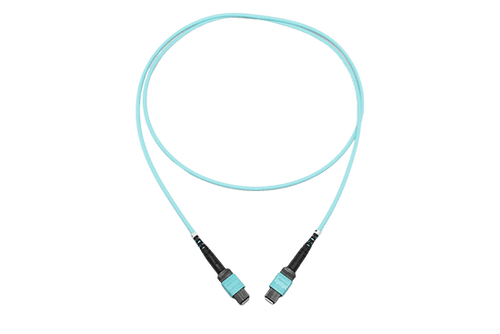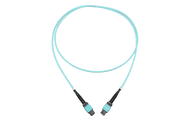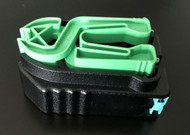Categories
Categories
- Home
- MTP®/MPO Fiber Assemblies
- MTP®/MPO Fiber Jumpers
- MTP® Jumpers
- MTP® OM4 Fiber Jumper
MTP® OM4 Fiber Jumper
Product Description
These MTP patch cables are designed for 40G QSFP+ SR4, 40G QSFP+ CSR4 and 100G QSFP28 SR4 optics. Use for direct connect or as jumpers for high density data center applications.
MTP OM4 jumpers offer the ultimate in MTP performance.
- 3mm OFNP rated jacket
- The most advanced MTP/MPO connector technology available
- Made in the USA
- Other lengths, fiber types, and cable types available
- J12M4MTFMTF Series Jumpers
If the length, cable construction, or fiber type you require is not listed, please contact us for a quote!
Quality Matters
Your network needs to be operational 100 percent of the time. Look for a fiber cable assembly manufacturer that uses the highest quality components and that has the equipment and expertise to guarantee exceptional product.
Connector
USConec MTP®
USConec is the leader in MPO connector technology.
Ferrule Type: MTP
Connector Housing Color: Aqua
Insertion Loss (IL): <0.5dB
Fiber Type
OFS fiber offers unsurpassed optical and mechanical characteristics while maintaining world class quality standards.
Cable
UL OFNP rated 12 fiber micro distribution style cable offers a compact 3mm OD cable design in a flexible plenum rated jacket.
Equipment and Expertise
When quality components are combined with expertise in termination, polish, inspection, and verification, you can be sure that you are getting a product that will not only perform well today, but will continue to perform for years to come. Understanding the latest innovations in the equipment required to truly ensure all optical parameters are optimized is necessary to produce top quality fiber assemblies. Inspecting end face geometries and polish quality are vital to creating fiber assemblies that will function at a high level for the life of the product. Utilizing the proper insertion loss and back reflection meters helps certify that the assemblies meet optical parameters.
METHOD A? METHOD B? Pins, no pins? Which is right for me?
When choosing an MTP/MPO fiber cable for your 40GbE or 100GbE application, you may find yourself wondering what Method A and Method B cabling are, and what they mean for your specific application.
Why does it matter?
QSFP+ modules are optical transceivers that use 4 lanes to transmit data and 4 lanes to receive data. They do this in a standardized format that accepts MPO type fiber connectors. MPO (Multi-fiber Push On) jumpers are used to connect QSFP+ modules together so that information may be transmitted between them. Because each QSFP+ module transmits on the same 4 lanes and receives on the same 4 lanes, a “crossover” needs to happen in the fiber cabling to make sure that the transmit lanes from one module talk to the receive lanes on the other module, and vice versa.
Method A cable- A method A MTP/MPO cable keeps the fibers aligned in the same channel on both ends (so fiber 1 is fiber one throughout, etc.).
Method B cable- A method B cable “flips” the fibers from one end to the other. In a 12 fiber connector, this means that fiber 1 starts in lane 1 on end 1 and routes to lane 12 on end 2 (fiber 2 starts in lane 2 and routes to lane 11, fiber 3 starts in lane 3 on one end and routes to lane 10, and fiber 4 starts in lane 4 and routes to lane 9).
So which method is right for your application?
Direct Connection between QSFP+ Modules
Generally speaking, if you are directly connecting between two QSFP+ modules, you will need to use a Method B cable, which makes the flip of the transmit/receive lanes. You will also want the cable to be non-pinned, as the QSFP+ module has alignment pins built in.
Connecting using trunk cables
If your network has backbone cabling, it is important to understand exactly what that cabling is (Method A, Method B, and pin configuration).
Method A
Many existing trunk cables are Method A and non-pinned, which makes the connection between the trunk and the module a little more involved. If you have a Method A trunk cable, you will need to use a Method A jumper on one end and a Method B jumper on the other end (there must be an odd number of flipped cables to achieve the correct port mapping). In addition, if the trunk cable is non-pinned, you will need to use a jumper that is pinned on one end (the end that mates to the trunk cable) to non-pinned (the end that mates to the QSFP+ module)
Method B
Method B trunk cables make it easy to choose the jumper that you need. As long as you are consistent, you can use either Method A or Method B jumpers on each end of the cable (you must use the same type on each end!). If the cable is pinned, you can use a standard non-pinned to non-pinned jumper. If it is non-pinned, you must use a pinned to non-pinned jumper.
Alternative-
If you are not sure which method or pin configuration your application requires, USCONEC has released their latest MPO connector technology, the MTP PRO, that is designed to be field configured for both pin configuration and polarity method. It requires a special tool, but makes swapping both pins and polarity fast and easy.
If you have any questions about your network configuration, contact one of our sales professionals to help ensure you get the cables you need.
 Loading... Please wait...
Loading... Please wait... 





